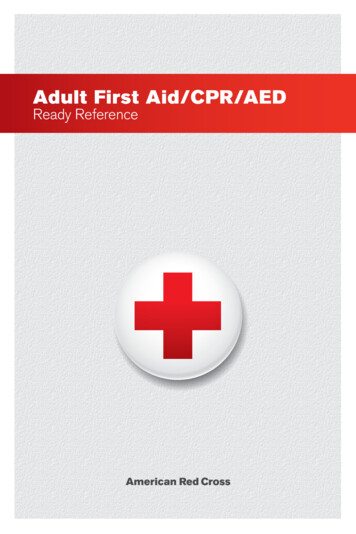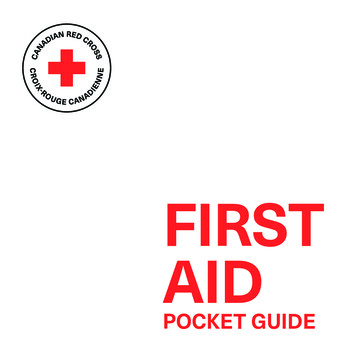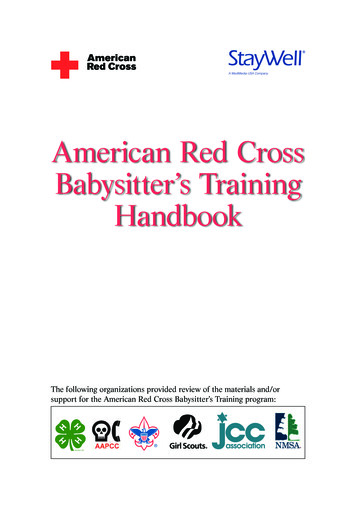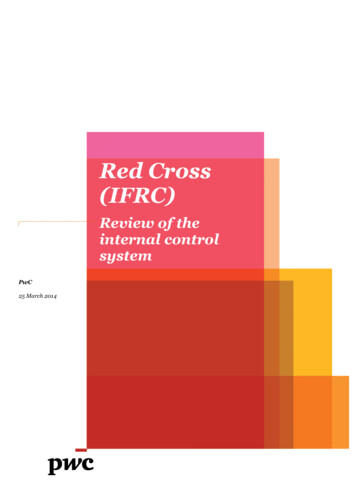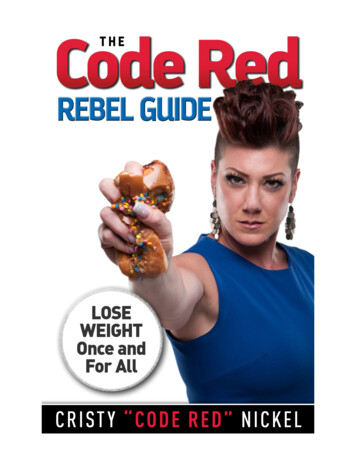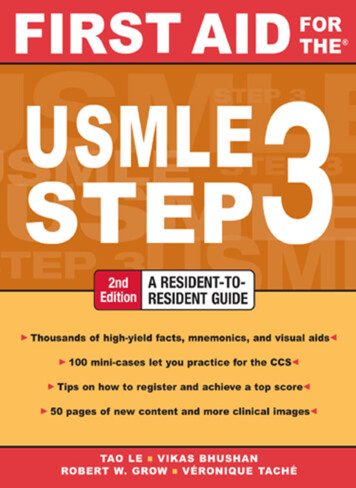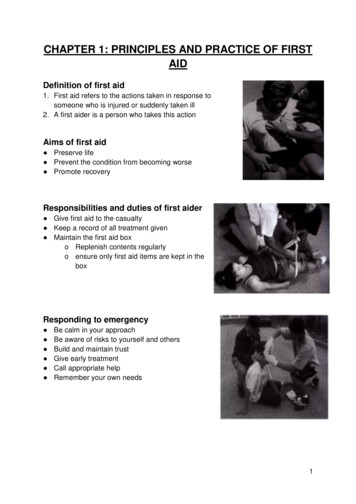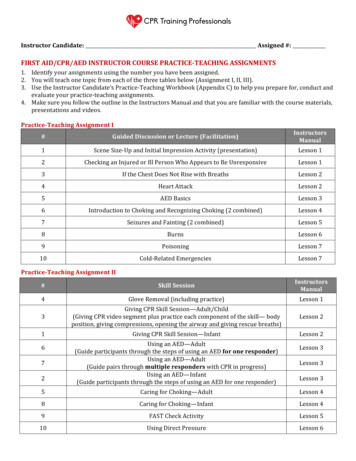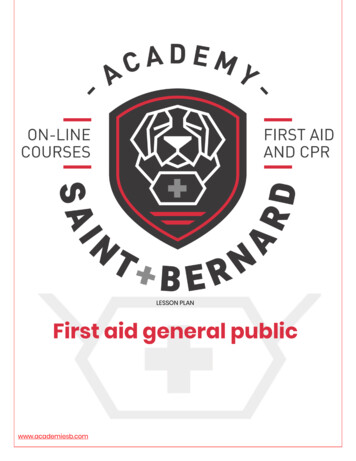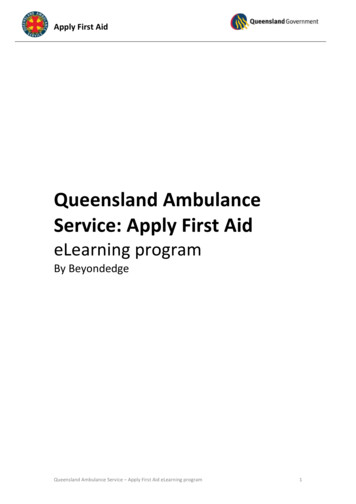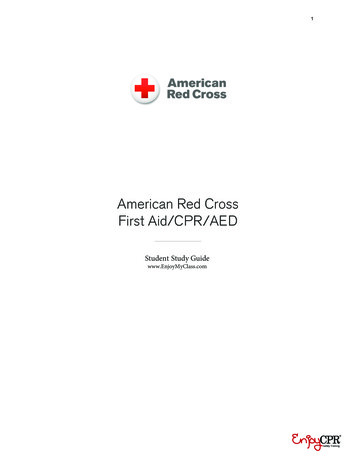
Transcription
1American Red CrossFirst Aid/CPR/AEDStudent Study Guidewww.EnjoyMyClass.com
2First Aid forCardiacEmergenciesand Choking
3CARDIACEMERGENCIESLife-threatening cardiac emergencies often strike close to home, wherewe live, work and play. When you know how to recognize and respondto a cardiac emergency, the life you could save is likely to be that ofsomeone you know—a family member, co-worker or neighbor. Because everyminute counts when a person is experiencing a cardiac emergency, the person’ssurvival often depends on lay responders acting quickly and giving appropriatecare until EMS personnel arrive and take over.
4Heart AttackA heart attack occurs when blood flow to part of theheart muscle is blocked (e.g., as a result of coronary arterydisease). Because the cells in the affected area of theheart muscle are not receiving the oxygen and nutrientsthey need, they die, causing permanent damage to theheart muscle (Figure 3-1). Seeking advanced medical careas soon as you recognize the signs and symptoms of aheart attack can minimize the damage to the heart and maysave the person’s life.Blockage inthe arteryWhen a person is having a heart attack,every minute counts.Signs and Symptomsof a Heart AttackDamaged heartmuscleFigure 3-1. A heart attack occurs when blood flow to theheart is blocked.Signs and symptoms of a heart attack vary from personto person, and can be different in women than they are inmen. Even people who have had a heart attack before maynot experience the same signs and symptoms if they havea second heart attack. A person who is having a heart attackmay show any of the following signs and symptoms: Chest pain, which can range from mild to unbearable. The person maycomplain of pressure, squeezing, tightness, aching or heaviness inthe chest. The pain or discomfort is persistent, lasting longer than 3to 5 minutes, or going away and then coming back. It is not relievedby resting, changing position or taking medication. It may be difficultto distinguish the pain of a heart attack from the pain of indigestion,heartburn or a muscle spasm. Discomfort or pain that spreads to one or both arms, the back, theshoulder, the neck, the jaw or the upper part of the stomach Dizziness or light-headedness Trouble breathing, including noisy breathing, shortness of breath orbreathing that is faster than normal Nausea or vomiting Pale, ashen (gray) or slightly bluish skin, especially around the faceand fingers Sweating A feeling of anxiety or impending doom Extreme fatigue (tiredness) Unresponsiveness
5MEN.WOMEN.often, but not always, experience the “classic”signs and symptoms of a heart attack:may experience the “classic” signsand symptoms but they are often milderand may be accompanied by moregeneral signs and symptoms such as:Chest pain, pressure, squeezing,tightness, aching or heaviness thatlasts longer than 3-5 minutes orgoes away and comes backHEARTATTACKShortness of breathNausea, vomiting or diarrheaFatigueDizzinessSweatingBack or jaw painRadiating pain to arm(s), shoulderor neckSecondary signs and symptoms mayinclude dizziness, loss of consciousness,sweating, nausea or shortness of breathFigure 3-2. Men and women often experience heart attacks differently.Although men often have the “classic” signs and symptoms of a heart attack, such as chest pain that radiatesdown one arm, women often have more subtle signs and symptoms or experience the signs and symptoms ofa heart attack differently than men do (Figure 3-2). For example, in women, the “classic” signs and symptomsmay be milder or accompanied by more general signs and symptoms such as shortness of breath; nauseaor vomiting; extreme fatigue; and dizziness or light-headedness. Because these signs and symptoms are sogeneral and nonspecific, women may experience them for hours, days or even weeks leading up to the heartattack but dismiss them as nothing out of the ordinary.The signs and symptoms of a heart attack may also be more subtle in people with certain medical conditions,such as diabetes.First Aid Care for a Heart AttackIf you think that a person is having a heart attack, call 9-1-1 or the designatedemergency number immediately. Trust your instincts. Many people who are having aheart attack delay seeking care because they hope they are experiencing signs andsymptoms of a more minor condition that will go away with time, such as indigestion,heartburn, a muscle strain or the flu. People often worry about calling an ambulanceand going to the emergency room for a “false alarm.” However, most people whodie of a heart attack die within 2 hours of first experiencing signs or symptoms. Evenwhen a heart attack is not fatal, early advanced medical care can help to minimizethe damage to the heart. Always seek advanced medical care as soon as signs andsymptoms of a heart attack are noted.If you think that someone might be having a heart attack, you should: Call 9-1-1 or the designated emergency numberimmediately. Never try to drive a person whois experiencing signs and symptoms of a heartattack to the hospital yourself. EMS personnelcan transport the person to the hospital safelywhile initiating care.Chapter 3 Cardiac Emergencies 37 Have the person stop what he or she is doingand rest in a comfortable position to reducethe heart’s need for oxygen. Many peopleexperiencing a heart attack find it easier tobreathe while sitting. First Aid/CPR/AED Participant’s Manual
6 Loosen any tight or uncomfortable clothing. Reassure the person. Anxiety increases theperson’s discomfort. If the person has a history of heart diseaseand takes a prescribed medication to relievechest pain (e.g., nitroglycerin), offer tolocate the medication and help the personto take it. If the person is responsive, able to chew andswallow, and allowed to have aspirin, you mayoffer two low-dose (81-mg) aspirin tablets orone 5-grain (325-mg) regular-strength aspirintablet (Box 3-1). Closely monitor the person’s condition untilEMS personnel arrive and take over. Noticeany changes in the person’s appearance orbehavior. If you are trained in giving CPR and usingan automated external defibrillator (AED), beprepared to give CPR and use an AED if theperson becomes unresponsive.Cardiac ArrestCardiac arrest is not the same as a heart attack. Remember,a heart attack occurs when blood flow to part of the heartmuscle is blocked, causing part of the heart muscle to die.Cardiac arrest, on the other hand, occurs when the heartstops beating or beats too ineffectively to circulate blood tothe brain and other vital organs. A network of special cells inthe heart muscle conducts electrical impulses that coordinatecontraction, causing the heart to beat rhythmically. In cardiacarrest, the electrical impulses become abnormal and chaotic.This causes the heart to lose the ability to beat rhythmically,or to stop beating altogether (Figure 3-3).Figure 3-3. Cardiac arrest occurs when theelectrical impulses that control the heartbeatbecome irregular and chaotic.
7Box 3-1. Aspirin for a Heart AttackYou may be able to help a person who is showingearly signs and symptoms of a heart attackby offering the person an appropriate dose ofaspirin. Aspirin can help to prevent blood clottingand is most effective when given soon after theonset of signs and symptoms of a heart attack.However, you should never delay calling 9-1-1or the designated emergency number to find oroffer aspirin.Before offering aspirin, make sure the person isresponsive, able to chew and swallow, and allowedto have aspirin. Ask the person: Are you allergic to aspirin? Do you have a stomach ulcer or stomachdisease? Are you taking any blood thinners, such aswarfarin (Coumadin )? Have you ever been told by a healthcareprovider to avoid taking aspirin?If the person answers “no”to each of these questions,you may offer the persontwo low-dose (81-mg)aspirin tablets or one5-grain (325-mg) regularstrength aspirin tablet.Have the person chew the aspirin completely.Chewing the aspirin speeds its absorption intothe bloodstream.Do not offer the personan aspirin-containingcombination productmeant to relievemultiple conditions, oranother type of painmedication, such asacetaminophen (Tylenol ),ibuprofen (Motrin , Advil ) or naproxen (Aleve ).These medications do not work the same wayaspirin does and are not beneficial for a personwho is experiencing a heart attack.Cardiovascular disease and certain congenital heart conditions (conditions that a person is born with) canincrease a person’s risk for cardiac arrest. Breathing emergencies, such as choking or drowning, can alsolead to cardiac arrest because if the body’s supply of oxygen is interrupted, the heart soon stops beating.Every organ in the body needs a steady supply of oxygen in order to work properly, and the heart is noexception. Severe trauma, electric shock and drugoverdose are other potential causes of cardiacarrest. Although cardiac arrest is more common in4-6 minutes:adults, it does occur in young people as well. TheBrain damage can beginmost common causes of cardiac arrest in children8-10 minutes: Brain damageand infants are breathing emergencies, congenitalcan become irreversible60heart disorders and trauma.55When the heart stops beating properly, the bodycannot survive for long. Breathing will soon stop,and the body’s organs will no longer receive theoxygen they need to function. Without oxygen,brain damage can begin in about 4 to 6 minutes,and the damage can become irreversible afterabout 8 to 10 minutes (Figure 3-4). Death occurswithin a matter of minutes if the person does notreceive immediate care.50560050104010020230451514020353025Figure 3-4. Every minute counts in cardiac arrest.
8Signs and Symptoms of Cardiac ArrestWhen a person experiences cardiacarrest, you may see the person suddenlycollapse. When you check the person,you will find that the person is notresponsive and not breathing, or onlygasping. (In an unresponsive person,isolated or infrequent gasping in theabsence of normal breathing may beagonal breaths, which can occur evenafter the heart has stopped beating.Agonal breaths are not breathing andare a sign of cardiac arrest.) The personhas no heartbeat.Cardiac arrest can happen suddenly and without any warning signs. When this occurs, the person is saidto have experienced sudden cardiac arrest. People who have a history of cardiovascular disease or acongenital heart disorder are at higher risk for sudden cardiac arrest. However, sudden cardiac arrest canhappen in people who appear healthy and have no known heart disease or other risk factors for the condition.A person who experiences sudden cardiac arrest is at very high risk for dying and needs immediate care.First Aid Care for Cardiac ArrestWhen a person experiences cardiac arrest, quick action on the part of those who witness the arrest iscrucial and gives the person the greatest chance for survival. The Cardiac Chain of Survival describesfive actions that, when performed in rapid succession, increase the person’s likelihood of surviving cardiacarrest (Box 3-2). In the Cardiac Chain of Survival, each link of the chain depends on, and is connected to,the other links.Four out of every five cardiac arrests in the United States occur outside of the hospital. That meansresponders like you are often responsible for initiating the Cardiac Chain of Survival. When you complete thefirst three links in the Cardiac Chain of Survival—recognizing cardiac arrest and activating the EMS system,immediately beginning CPR and using an AED as soon as possible—you give the person the best chance forsurviving the incident.For each minute that CPR and use of an AED are delayed, the person’schance for survival is reduced by about 10 percent.If you think that a person is in cardiac arrest: Have someone call 9-1-1 or the designated emergency number immediately. Begin CPR immediately. Use an AED as soon as possible.
9Box 3-2. The Cardiac Chain of SurvivalAdult Cardiac Chain of Survival Recognition of cardiac arrest andactivation of the emergency medicalservices (EMS) system. The sooner someonerecognizes that a person is in cardiac arrestand calls 9-1-1 or the designated emergencynumber, the sooner people capable of providingadvanced life support will arrive on the scene. Early CPR. CPR circulates oxygen-containingblood to the brain and other vital organs,helping to prevent brain damage and death. Early defibrillation. Defibrillation (deliveryof an electrical shock using an AED) mayrestore an effective heart rhythm, significantlyincreasing the person’s chances for survival. Early advanced life support. Provided byEMS personnel at the scene and en route tothe hospital, early advanced life support givesthe person access to emergency medical caredelivered by trained professionals. Integrated post–cardiac arrest care. Afterthe person is resuscitated, an interdisciplinaryteam of medical professionals works tostabilize the person’s medical condition,minimize complications, and diagnose and treatthe underlying cause of the cardiac arrest toimprove survival outcomes.Pediatric Cardiac Chain of Survival Prevention. Because cardiac arrest in childrenoften occurs as the result of a preventableinjury (such as trauma, drowning, choking orelectrocution), the Pediatric Cardiac Chain ofSurvival has “prevention” as the first link. Early CPR. CPR circulates oxygen-containingblood to the brain and other vital organs,helping to prevent brain damage and death. Activation of the emergency medicalservices (EMS) system. The sooner someonerecognizes that a person is in cardiac arrest andcalls 9-1-1 or the designated emergency number,the sooner people capable of providing advancedlife support will arrive on the scene. Early advanced life support. Providedby EMS personnel at the scene anden route to the hospital, early advancedlife support gives the person access toemergency medical care delivered by trainedprofessionals. Integrated post–cardiac arrestcare. After the person is resuscitated,an interdisciplinary team of medicalprofessionals works to stabilize the person’smedical condition, minimize complications,and diagnose and treat the underlying causeof the cardiac arrest to improve survivaloutcomes.
10CPRCPR, or cardiopulmonary resuscitation, is a skill thatis used when a person is in cardiac arrest to keepoxygenated blood moving to the brain and other vitalorgans until advanced medical help arrives (Figure 3-5).CPR involves giving sets of 30 chest compressionsfollowed by sets of 2 rescue breaths. When you givecompressions, you press down on the person’s chest.This squeezes (compresses) the heart between thebreastbone (sternum) and spine, moving blood out ofthe heart and to the brain and other vital organs. Aftereach compression, you must let the chest return to itsnormal position. This allows blood to flow back into theheart. The rescue breaths you give after each set of 30compressions deliver a fresh supply of oxygen into theperson’s lungs. When you give CPR, you help to keepoxygenated blood moving throughout the body, whichcan buy the person some time until advanced medicalhelp arrives.Figure 3-5. CPR keeps oxygen-containing bloodcirculating to the brain and other vital organs.Although full CPR (compressions and rescue breaths) is preferred,if you are unable or unwilling for any reason to give full CPR, youcan give compression-only CPR instead. In compression-onlyCPR, you give continuous chest compressions, with no rescuebreaths. After checking the scene and the person and calling 9-1-1or the designated emergency number, give chest compressionswithout stopping until another trained responder or EMS personneltake over or you notice an obvious sign of life.AEDTHE PROS KNOW.Many lay responders worry abouthurting the person (for example,by breaking the person’s ribs orbreastbone) while giving CPR,but a person who is in need ofCPR is clinically dead (i.e., theperson has no heartbeat and isnot breathing). It is very unlikelythat you will injure the personwhile giving CPR, but even if youdo, consider this: any injury youmay cause is secondary whencompared with the person’scurrent circumstances, and theinjury will heal with medical careand time. Remember: The worstthing to do is nothing!While CPR can help to prevent brain damage and death bykeeping oxygenated blood moving throughout the body, an AEDcan correct the underlying problem for some people who go intosudden cardiac arrest. Twoabnormal heart rhythmsin particular, ventricularfibrillation (V-fib) andventricular tachycardia (V-tach), can lead to sudden cardiacarrest. In V-fib, the heart muscle simply quivers (fibrillates) weaklyinstead of contracting strongly. In V-tach, the heart muscle contractstoo fast (tachy- means “fast”). Both abnormal rhythms impair theheart’s ability to pump and circulate blood throughout the body andare life threatening. However, in many cases, V-fib and V-tach canbe corrected by an electrical shock delivered by an AED. This shockdisrupts the heart’s electrical activity long enough to allow the heart tospontaneously develop an effective rhythm on its own. Starting CPRimmediately and using an AED as soon as possible gives the personthe best chance for surviving cardiac arrest (Figure 3-6).
11Figure 3-6. Immediately beginning CPR and using an AED as soon as possible gives the person the bestchance for survival.Giving CPRIf you check a person and find that he or she is unresponsive and not breathing or only gasping, beginCPR immediately, starting with chest compressions. Proper technique is important. Skill Sheets 3-1, 3-2and 3-3 describe step by step how to give CPR to an adult, child and infant, respectively. Table 3-1summarizes the key differences in giving CPR to an adult, child or infant.Giving CPR to an AdultFirst, make sure the person is lying face-up on a firm, flatsurface. For example, if the person is on a soft surfacelike a sofa or bed, quickly move him or her to the floorbefore you begin. Kneel beside the person. Position your hands. Place the heel of one handin the center of the person’s chest on the person’sbreastbone (sternum). If you feel the notch at theend of the breastbone, move your hand slightlytoward the person’s head. Place your other handon top of your first hand and interlace your fingersor hold them up so that your fingers are not on theperson’s chest. If you have arthritis in your hands,you can grasp the wrist of the hand positioned onthe chest with your other hand instead. The person’sclothing should not interfere with finding theproper hand position or your ability to give effectivecompressions. If it does, loosen or remove enoughclothing to allow deep compressions in the center ofthe person’s chest. Give a set of 30 compressions. Position yourbody so that your shoulders are directly over yourhands. This will let you push on the chest using astraight up-and-down motion, which moves the mostblood with each push and is also less tiring. Keeping
12TABLE 3-1 Comparison of CPR Technique in Adults, Children and InfantsAdultChildInfantAbout age 12 years or olderBetween the ages of 1 and 12 yearsYounger than 1 yearHand PositionTwo hands in center of chestTwo hands in center of chestTwo fingers on center of chest,just below the nipple lineCompress at least 2 inchesCompress about 2 inchesCompress about 1½ inchesRate: 100–120 compressions/minRate: 100–120 compressions/minRate: 100–120 compressions/minTilt head to slightly past-neutralposition; pinch nose shut andform seal over mouthTilt head to neutral position;form seal over mouth and nose30 chest compressions and2 rescue breaths30 chest compressions and2 rescue breathsChest CompressionsRescue BreathsTilt head to past-neutralposition; pinch nose shut andform seal over mouthSets30 chest compressions and2 rescue breaths
13your arms straight, push down at least 2 inches, and then let thechest completely return to its normal position. Push hard andpush fast! You want to go at a rate of 100–120 compressionsper minute. As you give compressions, count out loud up to30. Maintain a smooth, steady down-and-up rhythm and do notpause between compressions. Give a set of 2 rescue breaths. Once you have given 30compressions, give 2 rescue breaths. First, open the airwayusing the head-tilt/chin-lift maneuver. Place one of yourhands on the person’s forehead and two fingers of your otherhand on the bony part of the person’s chin. Tilt the person’s headback and lift the chin. For an adult, tilt the head to a past-neutralposition (see Table 3-1). If possible, use a CPR breathing barrierwhen you are giving rescue breaths, but do not delay rescuebreaths to find a breathing barrier or learn how to use it. Pinchthe person’s nose shut. Take a normal breath, make a completeseal over the person’s mouth with your mouth, and blow intothe person’s mouth to give the first rescue breath. Take anotherbreath, make a seal, and give the second rescue breath. Eachrescue breath should last about 1 second and make the person’schest rise. After you finish giving 2 rescue breaths, return togiving compressions as quickly as possible. The process ofgiving 2 rescue breaths and getting back to compressionsshould take less than 10 seconds. Never give more than 2rescue breaths per set. Table 3-2 describes how to troubleshootspecial situations when giving rescue breaths.THE PROS KNOW.Counting out loud as you givecompressions can help you tokeep a steady, even rhythm. Forcompressions 1 through 12, say“one and two and three and four andfive and six and ” up to 12. Whenyou get to 13, just say the number:“thirteen, fourteen, fifteen, sixteen ”up to 30. Push down as you say thenumber and come up as you say“and” (or the second syllable of thenumber). This will help you to keep asteady, even rhythm.THE PROS KNOW.Incorrect technique or body positioncan cause your arms and shouldersto tire quickly when you are givingcompressions. Use the weight ofyour upper body to compress thechest, not your arm muscles. Avoidrocking back and forth, becauserocking makes your compressionsless effective and wastes yourenergy. Also avoid leaning on thechest, because leaning prevents thechest from returning to its normalposition after each compression,limiting the amount of blood that canreturn to the heart.THE PROS KNOW.Once you begin CPR, continue giving sets of 30 chestcompressions and 2 rescue breaths until: You notice an obvious sign of life, such as movement. (If theperson shows an obvious sign of life, stop CPR, place theperson in the recovery position and continue to monitor theperson’s condition until EMS personnel take over.) An AED is ready to use and no other trained responders areavailable to assist you with the AED.When giving rescue breaths, keepthe person’s head tilted back andavoid taking too large of a breath orblowing too forcefully. Failing to keepthe person’s head tilted back, takingtoo large of a breath, or blowingtoo forcefully can force air into theperson’s stomach instead of intohis or her lungs, which can makethe person vomit and cause othercomplications. Remember: Keepthe head tilted back, take a normalbreath and blow just enough to makethe chest rise.
14TABLE 3-2 Special Situations: Rescue BreathingSpecial SituationSolutionThe breaths do not make the chest rise.Never give more than 2 rescue breaths per set. Ifthe first rescue breath does not cause the chestto rise, retilt the head to ensure that the airwayis properly opened and ensure that the person’snose and mouth are properly sealed before givingthe second rescue breath. If the second breathdoes not make the chest rise, an object may beblocking the person’s airway. Give CPR with onemodification: after each set of compressions andbefore giving rescue breaths, open the mouth, lookfor an object in the person’s mouth, and if you see it,remove it.The person vomits or there is fluid in the mouth.Roll the person onto his or her side and clear themouth of fluid using a gloved finger or a piece ofgauze. Then roll the person onto his or her back andresume giving care.You are unable to form a tight seal over theperson’s mouth (e.g., due to an injury).Use mouth-to-nose breathing instead. With theperson’s head tilted back, close the person’s mouthby pushing on the person’s chin. Make a completeseal over the person’s nose with your mouth andblow in for 1 second to make the chest rise.(Continued)
15Special SituationThe person has a tracheostomy or “stoma,” asurgically created opening in the front of the neckthat opens into the trachea (windpipe) to form analternate route for breathing when the upper airwayis blocked or damaged. You have performed approximately 2 minutesof CPR (5 sets of 30:2) and another trainedresponder is available to take over compressions.Giving chest compressions correctly is physicallytiring. If more than one responder is available andtrained in CPR, the responders should switchresponsibility for compressions every 2 minutes,or whenever the responder giving compressionsindicates that he or she is tiring. Switchingresponsibility for giving chest compressionsfrequently reduces responder fatigue, whichimproves the quality of chest compressions andleads to a better chance of survival for the person.SolutionUse mouth-to-stoma breathing instead. Expose theperson’s neck down to the breastbone and removeanything covering the stoma (e.g., a filter or stomacover). Wipe away any secretions from the stoma.Make a complete seal over the person’s stoma ortracheostomy tube with your mouth and blow in for1 second to make the chest rise. If the chest does not rise, the tracheostomytube may be blocked. Remove the inner tubeand try rescue breaths again. If you hear or feel air escaping from the person’smouth or nose, the person is a partial neckbreather (i.e., there is still a connection betweenthe trachea and the upper airway, and althoughthe person breathes mainly through the stoma,he or she is also able to breathe to some extentthrough the mouth and nose). Seal the person’smouth and nose with your hand or a tight-fittingmask so that air does not escape out of themouth or nose when you give rescue breathsinto the stoma. You have performed approximately 2 minutes ofCPR (5 sets of 30:2), you are alone and caringfor a child, and you need to call 9-1-1 or thedesignated emergency number. EMS personnel take over. You are alone and too tired to continue. The scene becomes unsafe.Giving CPR to a ChildGiving CPR to a child is very similar to giving CPR to anadult. However, in a child, you open the airway by tilting thehead to a slightly past-neutral position, rather than to a pastneutral position (see Table 3-1). Rather than compressingthe chest to a depth of at least 2 inches as you would for anadult, you compress the chest to a depth of about 2 inchesfor a child. Also, for a small child, you may only need to givecompressions with one hand, instead of two.
16Giving CPR to an InfantThe general principles of giving CPR to an infant arethe same as they are for children and adults. However,because the infant’s body is smaller, you will positionyour hands differently to deliver compressions. Placethe pads of two fingers on the center of the infant’schest, just below the nipple line. If you feel the notch atthe end of the infant’s breastbone, move your fingersslightly toward the infant’s head. Place your other handon the infant’s forehead. Give compressions by usingthe pads of your fingers to compress the chest about1½ inches.When you give rescue breaths, open the airway by tilting the head to a neutral position (see Table 3-1).Instead of pinching the nose shut and covering the mouth with your mouth, cover the infant’s nose and mouthwith your mouth to form a seal.Using an AEDDifferent types of AEDs are available, but all aresimilar to operate and use visual displays, voiceprompts or both to guide the responder. If your placeof employment has an AED on site, know where it islocated, how to operate it and how to maintain it (Box3-3). Also take note of the location of AEDs in publicplaces that you frequent, such as shopping centers,airports, recreation centers and sports arenas.When a person is in cardiac arrest, use an AED as soonas possible. Skill Sheet 3-4 describes how to use anAED step by step. Environmental and person-specificconsiderations for safe and effective AED use are givenin Box 3-4.Using an AED on an AdultTo use an AED, first turn the device on. Remove or cut awayclothing and undergarments to expose the person’s chest. Ifthe person’s chest is wet, dry it using a towel or gauze pad.Dry skin helps the AED pads to stick properly. Do not use analcohol wipe to dry the skin because alcohol is flammable.Next, apply the AED pads. Peel the backing off the pads asdirected, one at a time, to expose the adhesive. Place onepad on the upper right side of the person’s chest and theother pad on the lower left side of the person’s chest belowthe armpit, pressing firmly to adhere (Figure 3-7). Plug theconnector cable into the AED (if necessary) and follow thedevice’s directions. Most AEDs will begin to analyze the heartrhythm automatically, but some may require you to push an“analyze” button to start this process. No one should touchthe person while the AED is analyzing the heart rhythmbecause this could result in a faulty reading. Next, the AEDFigure 3-7. Place one AED pad on the upperright side of the chest and the other on thelower left side of the chest, below the armpit.
17will tell you to push the “shock” button if a shock is advised. Again, avoid touching the person, becauseanyone who is touching the person while the device is delivering a shock is at risk for receiving a shock aswell. After a shock is delivered (or if the AED determines that no shock is necessary), immediately resumeCPR, starting with compressions. The AED will continue to check the heart rhythm every 2 minutes. Listenfor prompts from the AED and continue giving CPR and using the AED until you notice an obvious sign of lifeor EMS personnel arrive. I
First Aid Care for a Heart Attack. If you think that a person is having a heart attack, call 9-1-1 or the designated . emergency number immediately. Trust your instincts. Many people who are having a heart attack delay seeking care because they hope they are experiencing signs and
